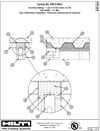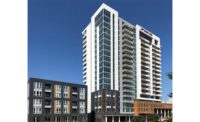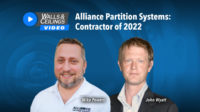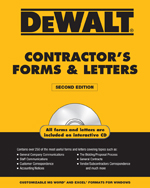
The Firestop Contractors International Association Accreditation and Standards Committees have built a model for better construction quality based on independent audits by FM & UL of Contracting Company Quality Manuals, and through standards for third party independent inspections of installed firestop systems.
To provide a contractor quality management program, the FCIA Accreditation Committee volunteers worked with Factory Mutual Global, Approvals Division, (now known as FM Approvals), on FM 4991-Standard for the Approval of Firestop Contractors, and UL to develop the UL Qualified Firestop Contractor Program.
FCIA Contractor and Manufacturer member volunteers on the FCIA Standards Committee also worked to develop ASTM E2174-01 Standard Practice for On-Site Inspection of Installed Fire Stops. ASTM E2174-01 has been updated to ASTM E2174-09. An additional standard for inspection of joint systems for walltops, expansion and construction joints, plus perimeter fire protection, ASTM E2393-04, Standard Practice for On-Site Inspection of Installed Fire Resistive Joint Systems and Perimeter Fire Barriers was published in 2004, and updated in 2009.

Hilti HWD 0042, Head of Wall Detail for firestopping. Detail courtesy of Hilti Inc.
The FM 4991 & UL Qualified Firestop Contractor programs are quality management systems evaluations where the contractor has a Designated Responsible Individual, whose quality manuals are audited by FM or UL’s personnel.
During the approval/qualification process, FM or UL visits the firestop contracting firm, audits based on the contractors’ quality manual, and then checks the installed firestop system in the field. The Contractor Quality Manual outlines procedures used by contractors to get firestopping systems selected and installed to the zero tolerance protocol for firestopping, controlled by the DRI. FM and UL then find the company either conforming or not conforming to requirements. FM or UL do not issue Approval or Qualification to individuals, only the Firestopping Company.
Initial cost is between $6,000 and $9,000 for the initial audit, then $3,000 for the follow up audit required annually. CEU’s are required for the DRI to maintain their status in the program.
MORE ON CONTRACTOR QUALITY MANUALS
The contractor firm must write a quality manual, which describes processes, procedures and people that get systems installed as tested and listed. The firm’s processes are reviewed by FM or UL step by step; from the office to the job site. Contractor Quality Manuals are written to reflect the firms’ own unique procedures, and reflect how the company operates, not how FM or UL think they should operate.
Quality manuals focus on systems selection, communication of the appropriate systems to the field, and verifying installation to tested and listed systems and engineering judgments by manufacturers, testing laboratories. Each firm will have their own procedures, their competitive advantage.
The Firestop Contractors International Association Standards Committee Chair, (2000 through 2005), Don Sabrsula, FireSafe of Houston worked with industry contractors and manufacturers to assemble and ballot the first standard for inspection of firestopping.
QUALITY IS THE WHOLE PROCESS
Firestop manufacturers test their products and publish systems in the Underwriters Laboratories, Omega Point Laboratories, Warnock Hersey International and Factory Mutual Approvals (FM) Directories, setting the stage for their suitability for use. ASTM E2174 and ASTM E2393 inspection protocols are a package, together with FM 4991 and the UL Qualified Firestop Contractor Program, which affects the installation protocol of firestop systems to result in better overall project quality. ASTM E2174 and ASTM E2393 set the stage verifying that the firestopping has been installed to classified firestop systems designs.
It has been found through actual project reviews by inspection agencies, that inspection will cost much more when projects employ the “he or she who pokes hole, fills it” or multiple trade methods for firestopping. Inspectors tell FCIA that the inspection costs rise dramatically due to multiple trades involved and submittal package variances to field applications.
We believe the complete approach, a Specialty Firestop Contractor providing quality services for firestop systems installation, with inspection by qualified inspectors to verify that the process works, allows the best method for all. By offering value to the purchaser of firestopping through investment in the correct contractor and inspection means value is received for contractor systems selection and installation services rather than heavily weighted in inspection.
Architects, specifiers, engineers, building code officials, and fire marshals, should consider specifying tested and listed firestop systems made by quality manufacturers, installed by a Specialty Firestop Contractor and/or FM 4991 Approved or UL Qualified Firestop Contractor, to make the total quality management process complete.
These installation and inspection standards are referenced in specifications nationally and internationally, with inspection companies getting more involved in firestopping. The ICC Code Process is also evaluating them for inclusion as well, based on submissions by FCIA.
FCIA’s Apprenticeship Committee has also worked to bring quality to the firestopping trade. FCIA’s leadership started conversations with the US Department of Labor in 2005, and through Apprenticeship Chair Bob Hasting, has a working four-year firestop/containment worker apprenticeship program operating in the State of Washington.
IAPMO UPC Plumbing Code and ASME A 112.20.2 – FCIA has been following the International Association of Plumbing and Mechanical Officials code change proposal that could mandate a person with four years documented experience in the installation of piping, be the only person that can install firestopping around all piping.
OBJECTION TO STANDARD
A United Association of Plumbers, Pipe Fitters Union of plumbers, sprinkler fitters employee chaired the American Society of Mechanical Engineers group to get this ASME A 112.20.2 standard written. FCIA objected heavily to the four years experience in piping requirement.
So far, the States of California and Oregon have amended the ASME A 112.20.2 standard out the IAPMO 2009 Uniform Plumbing Code. Additionally, FCIA appealed decisions at IAPMO to the IAPMO Standards Council, IAPMO Board of Directors, and the American National Standards Institute Board of Standards Review. We recently received a ruling stating that the four years of experience is not mandatory.
Also, at ASME’s A 112 Main Committee, it was voted to move the standard to the American Society of Mechanical Engineers. To understand who’s who, and what’s what, check out www.fcia.org and newsletters.
The key point FCIA has made was that firestopping is not about the penetrating item. Firestopping is about the fire resistance rated and smoke resistant wall or floor, plus the firestopping that extends the rating of the wall/floor into an opening, gap or joint. Watch FCIA.org for resource information you can use.
VIBRANT INDUSTRY
The firestopping industry is very exciting. There’s a lot going on, with participants nationally and internationally. Firestopping is evolving into a trade, with all types of firestopping done by a single contractor: penetrations, joints, perimeter fire containment, head of wall systems. Those firms that embrace the quality management systems protocols in FM 4991, and the UL Qualified Firestop Contractor Program, can use tools to make their own luck in the contracting world.
The FCIA is celebrating its tenth year at the FCIA Firestop Industry Conference & Trade Show this November. To learn more about this industry, and be part of the program, join FCIA and come to the conference. The membership and committees are very active in the industry, working to develop better programs to protect people and property in buildings. W&C
Sidebar: Specification language
Below is suggested specification language from the FCIA Specification onwww.fcia.org:Contractor Qualifications
Acceptable installer firms shall be:
FM Approved in accordance with FM Standard 4991 – Approval of Firestop Contractors, and/or UL Qualified Firestop Contractor.
Licensed by the state or local authority, where applicable.
Shown to have successfully completed not less than five comparable scale projects.
Firestop Contractors International Association Contractor Member in good standing.
Inspection
Inspection: Independent inspection agency employed and paid by owner, will examine penetration firestopping in accordance with ASTM E2174-09, “Standard Practice for On-Site Inspection of Installed Fire Stops.” And ASTM E2393-09, Inspection agency to examine firestopping and will determine, in general, that firestopping has been installed in compliance with requirements of tested and listed firestop system.
The inspector shall advise the contractor of any deficiencies noted within one (1) working day.
Do not proceed to enclose firestopping with other construction until inspection agency has verified that the firestop installation complies with the requirements.
Where deficiencies are found, repair or replace the firestopping so that it complies with requirements of tested and listed system design.
Inspector Qualifications:
From ASTM E2174 & ASTM E2393: “Firestop Inspector not to be related to installing contractor firm in any way, including arms length business relationships including subsidiaries, distributors, manufacturers representatives, or manufacturers supplying products for use in firestop systems.”
From IAS AC 291: “There are developing requirements for the inspector at the inspection agency to pass the FM 4991 or UL Firestop DRI Examinations.”






Report Abusive Comment